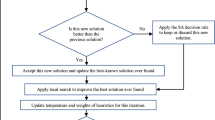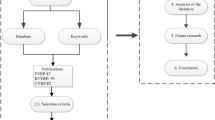Abstract
A tandem AGV configuration connects all cells of a manufacturing facility/plant by means of non-overlapping, single-vehicle closed loops. Each loop has at least one additional P/D station, provided as an interface between adjacent loops. This study describes the development of tabu search and genetic algorithm procedures for designing tandem AGV systems. The objective is to minimize the maximum workload of the system. Both algorithms have mechanisms to prevent solutions with intersecting loops. The new algorithms and the partitioning algorithm presented by Bozer and Srinivasan are compared using randomly generated test problems. Results show that for large-scale problems, the partitioning algorithm often leads to infeasible configurations with crossed loops in spite of its shorter running time. However the newly developed algorithm avoids infeasible configurations and often yields better objective function values.
Similar content being viewed by others
References
Tompkins JA, White JA, Bozer YA, Tanchoco JMA (2003) Facilities planning, 3rd edn. Wiley, Chichester
Asef-Vaziri A, Laporte L (2005) Loop based facility planning and material handling. Europ J Oper Res 164:1–11
Gaskin RJ, Tanchoco JMA (1987) Flow path design for automated guided vehicle system. Int J Prod Res 25:667–676
Gaskin RJ, Tanchoco RMA, Taghaboni F (1989) Virtual flow paths for free ranging automated guided vehicle systems. Int J Prod Res 27:91–100
Kaspi M, Tanchoco JMA (1990) Optimal flow path design of unidirectional AGV systems. Int J Prod Res 28:1023–1030
Venkataramanan MA, Wilson KA (1991) A branch- and- bound algorithm for flow path design of automated guided vehicle systems. Naval Res Logist Quart 38:431–445
Sinriech D, Tanchoco JMA (1991) Intersection graph method for AGV flow path design. Int J Prod Res 29:1725–1732
Kouvelis P, Gutierrez GJ, Chiang WC (1992) Heuristic unidirectional flow path design approach for automated guided vehicle systems. Int J Prod Res 30:1327–1351
Seo Y, Egbelu PJ (1995) Flexible guide path design for automated guided vehicle systems. Int J Prod Res 33:1135–1156
Sun XC, Tchernev N (1996) Impact of empty vehicle flow on optimal flow path design for unidirectional AGV systems. Int J Prod Res 34:2827–2852
Zanjirani Farahani R, Tari FG (2001) Optimal flow path designing of unidirectional AGV systems. Intl J Engin Sci 12:31–44
Zanjirani Farahani R, Tari FG (2002) A branch & bound method for finding flow-path designing of AGV systems. IIE Trans A Basics 15:81–90
Kaspi M, Kesselman U, Tanchoco JMA (2002) Optimal solution for the flow path design problem of a balanced unidirectional AGV system. Int J Prod Res 40:349–401
Ko KC, Egbelu PJ (2003) Unidirectional AGV guide path network design: a heuristic algorithm. Int J Prod Res 41:2325–2343
Bozer YA, Srinivasan MM (1989) Tandem configurations for AGV systems offer simplicity and flexibility. Industr Eng 21:23–27
Bozer YA, Srinivasan MM (1991) Tandem configuration for automated guided vehicle systems and the analysis of single vehicle loops. IIE Trans 23:72–82
Bozer YA, Srinivasan MM (1992) Tandem AGV systems: a partitioning algorithm and performance comparison with conventional AGV systems. Europ J Oper Res 63:173–191
Lin JT, Chang CCK, Liu WC (1994) A load routing problem in a tandem-configuration automated guided vehicle system. Int J Prod Res 32:411–427
Laporte G, Zanjirani Farahani R, Miandoabchi E (2006) Designing an efficient method for tandem AGV network design problem using tabu search. Appl Math Comput (in press)
Tanchoco JMA, Sinriech D (1992) OSL-Optimal Single Loop guide paths for AGVs. Int J Prod Res 30:665–681
Sinriech D, Tanchoco JMA (1993) Solution methods for the mathematical models of single loop AGV systems. Int J Prod Res 31:705–726
Banerjee P, Zhou Y (1995) Facilities layout design optimization with single loop material flow path configuration. Int J Prod Res 33:183–203
Laporte G, Asef-Vaziri A, Sriskandarajah C (1996) Some application of the generalized traveling salesman problem. J Oper Res Society 47:1461–1467
Asef-Vaziri A, Laporte G, Sriskandarajah C (2000) The block layout shortest loop design problem. IIE Trans 32:724–734
Asef-Vaziri A, Dessouky M, Sriskandarajah C (2001) A loop material flow system design for automated guided vehicles. Intl J Flex Manuf Syst 13:33–48
Asef-Vaziri A, Laporte L, Ortiz R (2006) Exact and heuristic procedures for the material handling circular flow path design problem. Europ J Oper Res DOI 10.1016/j.ejor.2005.08.023
Zanjirani Farahani R, Laporte G, Sharifyazdi M (2005) A practical exact algorithm for the shortest loop design problem in a block layout. Int J Prod Res 43:1879–1887
Zanjirani Farahani R, Pourakbar M, Miandoabchi E (2006b) Developing exact and tabu search algorithms for simultaneously determining AGV loop and P/D stations in single loop systems. Int J Prod Res (in press)
Zanjirani Farahani R, Karimi B, Tamadon S (2006a) Designing an efficient method for simultaneously determining the loop and the location of the P/D stations using genetic algorithm. Int J Prod Res (in press)
Kim CW, Tanchoco JMA (1991) Conflict-free shortest-time bi-directional AGV routing. Int J Prod Res 29:2377–2391
Chhajed D, Montreuil B, Lowe T (1992) Flow network design for manufacturing systems layout. Europ J Oper Res 57:145–161
Rajagopalan S, Heragu SS, Taylor GD (2004) A lagrangian relaxation approach to solving the integrated pick-up/drop-off point and AGV flow path design problem. Appl Math Model 28:735–750
Sinriech D, Tanchoco JMA (1994) SFT-Segmented Flow Topology. In: Tanchoco JMA (ed) Material flow system in manufacturing. Chapman and Hall, London, pp 200–235
Sinriech D, Tanchoco JMA (1995) An introduction to the segmented flow approach to discrete material flow systems. Int J Prod Res 33:3381–3410
Sinriech D, Tanchoco JMA (1997) Design procedures and implementation of the Segmented Flow Topology (SFT) for discrete material flow systems. IIE Trans 29:323–335
Barad M, Sinriech D (1998) A petri net model for the operational design and analysis of Segmented Flow Topology (SFT) AGV system. Int J Prod Res 36:1401–1426
Vis IFA (2006) Survey of research in the design and control of automated guided vehicle systems. Europ J Oper Res 170:677–709
Hsieh LF, Sha DY (1996) A design process for tandem automated guided vehicle systems: the concurrent design of machine layout and guided vehicle routes in tandem automated guided vehicle systems. Integ Manuf Syst 7:30–38
Liu FH, Chen JT (1997) Analytical framework for designing the divided automated guided vehicles system. Int J Industr Engin 4(2):90–102
Aarab A, Chetto H, Radouance L (1999) Flow path design for AGV systems. Stud Inform Contr 8(2):97–106
Yu W, Egbelu P (2001) Design of a variable path tandem layout for automated guided vehicle systems. J Manuf Syst 20:305–319
Kim KS, Chung BD, Jae M (2003) A design for a tandem AGVS with multi-load AGVs. Int J Adv Manuf Technol 22:744–752
Bozer YA, Lee CG (2004) Using existing workstations as transfer stations in tandem AGV systems. J Manuf Syst 23:229–241
Ventura JA, Lee CU (2001) Tandem loop with multiple vehicles configuration for automated guided vehicle systems. J Manuf Syst 20:153–165
Huang C (1997) Design of material transportation system for tandem automated guided vehicle systems. Int J Prod Res 35:943–953
Farling BE, Mosier CT, Mahmoodi F (2001) Analysis of automated guided vehicle configuration in flexible manufacturing systems. Int J Prod Res 39:4239–4260
Ross EA, Mahmoodi F, Mosier CT (1996) Tandem configuration automated guided vehicle systems: a comparative study. Decis Sci 27:81–102
Choi HG, Kwon HJ, Lee J (1994) Traditional and tandem AGV system layouts: a simulation study. Simul 63(2):85–93
Ho YC, Hsieh PF (2004) A machine-to-loop assignment and layout design methodology for tandem AGV systems with multiple-load vehicles. Int J Prod Res 42(4):801–832
Bartholdi JJ, Platzman LK (1989) Decentralized control of automated guided vehicles on a simple loop. IIE Trans 21(1):76–81
Glover F (1989) Tabu search-Part I. ORSA J Comput 1:190–206
Glover F (1990) Tabu search-Part II. ORSA J Comput 2:4–32
Glover F, Taillard E, De Werra D (1993) A user’s guide to tabu search. Annal Oper Res 41:3–28
Holland JH (1975) Adaptation in natural and artificial systems. University of Michigan Press, Ann Arbor, MI
Seber GAF (1984) Multivariate observations. Wiley, New York
Roe A (1997) User’s guide for LINDO and LINGO, Windows Versions. Duxbury Press, Belmont (Cal.)
Author information
Authors and Affiliations
Corresponding author
Rights and permissions
About this article
Cite this article
Zanjirani Farahani, R., Laporte, G., Miandoabchi, E. et al. Designing efficient methods for the tandem AGV network design problem using tabu search and genetic algorithm. Int J Adv Manuf Technol 36, 996–1009 (2008). https://doi.org/10.1007/s00170-006-0909-4
Received:
Accepted:
Published:
Issue Date:
DOI: https://doi.org/10.1007/s00170-006-0909-4




